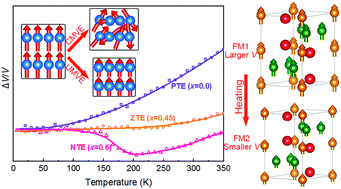Negative thermal expansion in (Sc,Ti)Fe2 induced by an unconventional magnetovolume effect†
Abstract
Negative thermal expansion (NTE) has been found in some magnetic functional materials due to the magnetovolume effect (MVE), in which an order-to-disorder magnetic transition occurs. Here, we report an unconventional MVE which can induce the crossover from the common positive thermal expansion of the end members of ScFe2 and TiFe2 to the NTE in the solid solution of (Sc1−xTix)Fe2 (x = 0.6, αV = −28.36 × 10−6 K−1, 125–205 K). The direct evidence of neutron powder diffraction and first-principles calculations discloses that the decrease of intrinsic magnetic moments at the Fe(2a) site results in the ferromagnetic transition from one to another, which causes a stronger negative contribution to thermal expansion than the conventional MVE. The pair distribution function analysis verifies that the decrease in the nearest distance of Fe(6h)–Fe(6h) lying in the ab plane results in the shrinkage of the a(b) axis. The analysis of anisotropic atomic displacement parameters excludes the phonon induced NTE mechanism. Furthermore, an intriguing zero thermal expansion has been found in Sc0.55Ti0.45Fe2 (10–250 K). The present study provides an approach to achieve NTE or controllable thermal expansion, which may be used to enhance other magnetic-related effects, such as the magnetocaloric and barocaloric effect.



 Please wait while we load your content...
Please wait while we load your content...